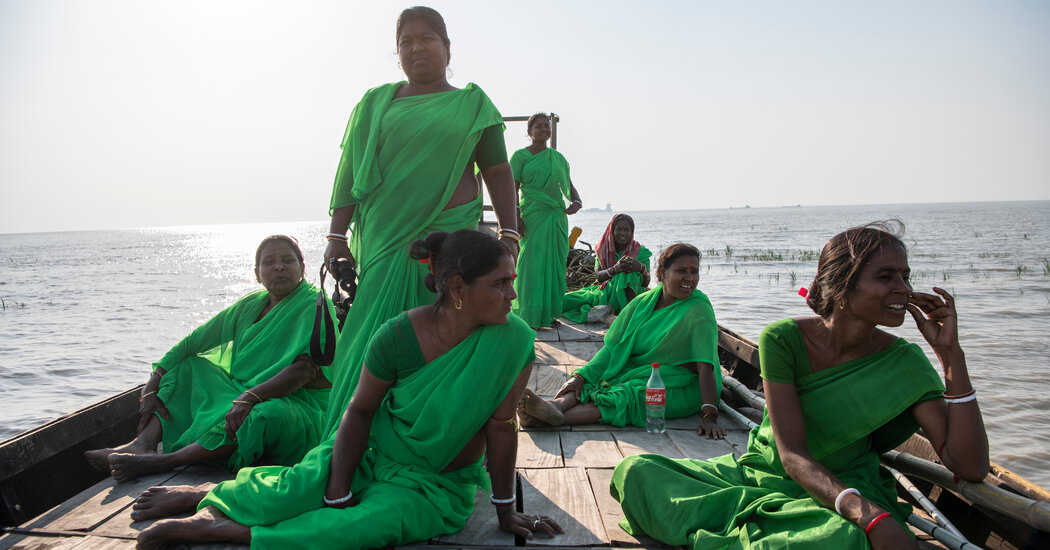
LAKSHMIPUR, India — The women adjusted their binoculars around their necks, secured their bright green saris and climbed onto a motorboat to begin their weekly patrol in the Sundarbans, one of the largest deltas in the world and an urgent case study on the effects of climate change.
As sea levels rise, eroding embankments and pushing water closer to their doorsteps, the residents of the hundreds of villages in the Sundarbans — an immense network of rivers, tidal flats, small islands and vast mangrove forests straddling India and Bangladesh — have found their lives and livelihoods at risk.
In the absence of much government support, women like Aparna Dhara, with help from a nonprofit environmental conservation organization, have devised their own solution: planting hundreds of thousands of additional mangrove trees to bolster their role as protective barriers.
“Our land and livelihoods have been battered many times over by raging cyclones and unpredictable, heavy rains,” said Ms. Dhara, 30, as she and the other women in the boat discussed where they needed to plant more trees. “The rhythm of our lives is dependent on the ebb and flow of the water around us, making the mangroves our lifelines.”
Their mission has a devastating backstory.
After Cyclone Aila slammed into the region in 2009, causing floods and mudslides, nearly 200 people lost their lives. The storm exposed the increasing dangers posed by climate change to the millions of people living in the low-lying Sundarbans, thousands of square miles of wetland jutting into the Bay of Bengal.
Amid the rising waters, crocodiles have begun entering villages. Erratic monsoon seasons have replaced more predictable ones. And higher salinity in the water has killed off fish “as if the entire area had been crushed under the thumb,” said Ajanta Dey, a Kolkata-based conservationist.
The harm has been disproportionately felt by the most marginalized in the Sundarbans, whose population on India’s side of the border is about 4.5 million. Many live in areas reached only after dayslong boat trips.
A few years ago, as Ms. Dey went around documenting the post-cyclone wreckage, women like Ms. Dhara approached her and pointed to areas where their homes had once stood. Ms. Dey suggested planting more mangroves between existing embankments and open water. By 2015, over 15,000 women had signed up to for the mission, according to Ms. Dey, program director at Nature Environment and Wildlife Society.
While all are welcome to participate, many men from the Sundarbans migrate to cities for work, meaning it’s the villages’ women who are often leading the climate change fight.
The women, drawing on their deep knowledge of the Sundarbans, make hand-drawn maps of areas where mangroves can be planted. They nurture seeds into saplings and then, in baskets or on boats, transport the young trees and dig in the mud flats to plant them. Later, they track their growth on a mobile app.
In Ms. Dhara’s village, Lakshmipur, the number of acres covered with mangroves has grown to 2,224 from 343 in the last decade. In areas that had been barren-looking mud flats just a few years ago, cranes, gulls and herons abound in the flat rounded leaves of the mangrove trees.
Mangroves, found only in tropical and subtropical climates, are distinctive for their ability to survive in brackish water. Research has shown mangrove forests to be an excellent way to mitigate the effects of climate change, especially the storm surge accompanying cyclones, by reducing the height and speed of waves. Mangroves also help reduce greenhouse gases, as they have high rates of carbon capture.
In addition to reducing the effects of flooding with their dense tangle of roots, they also help increase fish hauls by providing a natural habitat for crabs and other crustaceans.
Set against the picturesque Muri Ganga river, Lakshmipur lies in the southwestern part of the Sundarbans, whose vast expanse is home to tigers, lush mangrove forests and rare snakes.
In the village, every house has its own pond, where people bathe, wash clothes and draw water to irrigate their vegetable farms.
On a recent afternoon, women wove fishing nets in the alleys. Chicks ran through small farms flush with cauliflowers and tomatoes. A brick and cement embankment encircled one side of the village, which is home to over 2,500 people.
“Thousands of acres of village land has been lost to the river in the past 50 years,” said Bhaskar Mistry, 60, a village council member, who was born in Lakshmipur and has witnessed hundreds of storms there.
As the brackish water around them has continued encroaching on the village’s land, people have stopped growing rice, their staple crop, because the soil is too salty.
Ms. Dhara’s in-laws lost two of their homes, a big farm and their sweet water pond to the rising waters.
Years of living with the consequences of climate change have left Ms. Dhara gripped with anxiety, she said, unable to sleep soundly when it rains, afraid of what may come next.
While many in the village share her sense of living on the edge of a climate disaster, Ms. Dhara said it nonetheless seemed impossible at first to persuade her family to let her join the group of women planting mangroves back in 2013.
“Who will cook and wash and clean the house if you work? You are the daughter-in-law of the house and must work indoors like we did,” Ms. Dhara recalled her mother-in-law shouting at her. For many other women in the Sundarbans, the story is similar.
“Not only are these women supremely at risk, but they often aren’t even able to have their voices heard about how to avert that risk or how to avoid it,” said John Knox, a former U.N. special rapporteur on human rights and the environment.
But Ms. Dhara persisted, and was able to convince her family that the trees would not only help keep the village safe from floods, but were also a chance to earn extra income. Ms. Dey’s organization pays the women for growing and planting mangrove saplings, and also helps them sell fish, vegetables, honey, eggs and other local goods.
The women participating in the program earn, on average, about $430 a year, a meaningful boost to a family in India where the per capita income is about $1,900.
This sort of financial incentive in environmental restoration efforts is essential in getting local communities to participate, Ms. Dey said, especially women, whose families would not let them take part otherwise.
The women, finding that their fellow villagers weren’t taking their work seriously when they were wearing their everyday saris, also asked to be furnished with uniforms. The official-looking green ones they now have both symbolize the nature of their efforts and lend heft and credence to their mission, the women said.
In the village of Gobardhanpur, near the border with Bangladesh, a group of women ranging in age from 25 to 60 gathered in a mangrove nursery. Every monsoon, the women plant new seeds, braving snakes, thorny bushes and biting snails that hide deep in the mud.
But, they say, the benefits of all the hard work are clear.
As cyclones intensified over the last few years, everyone in the village noticed that the embankment next to the new mangrove forest did not give way. The wall of trees slowed the incoming water, lessening its impact by the time it reached the embankment.
Last fall, a group of men began sneaking into the mangrove forest to harvest a type of snail buried within the mangrove roots. They were uprooting the trees, and to Madhumita Bagh, who helps oversee the village’s mangrove efforts, it was like someone beating her child. She complained to the police, and the men stopped coming.
“We are not giving up,” said Ms. Bagh, who teaches women in neighboring villages about the mangrove program.
Ms. Dhara said she has also developed a familial affection for the trees.
“The mangroves are like our children,” she said. “If we don’t nurture them, they will die.”
Over the last couple years, the local government has begun granting participants public land to use as mangrove nurseries and has been buying some of the saplings from the women. They, too, have been impressed by their efforts.
“The women are like silent climate warriors,” said Shantanu Singha Thakur, an official with the district government.




